Introduction to Biological Classification | Biology for Grade 11 PDF Download
What is Biological Classification?
Biological classification is the scientific procedure of arranging organisms into groups and subgroups on the basis of their similarities and dissimilarities and placing the groups in a hierarchy of categories.
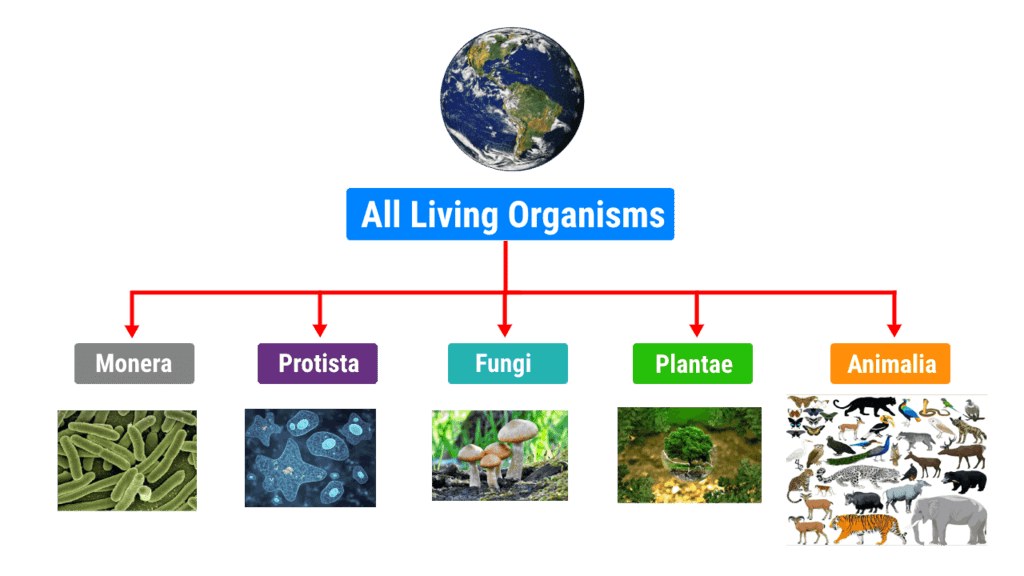
Need for Classification
A proper system of classification is a must because of the following reasons:
(1) It is not possible to study every organism. The study of one or two organisms of a group gives sufficient information about the essential features of the group.
(2) Without any system of classification organisms cannot be identified.
(3) All types of organisms do not occur in one locality.
(4) The organisms of the past cannot be studied without a system of classification.
(5) Classification helps in knowing the relationships of organisms.
(6) On the basis of relationships and simplicity or complexity found in the members of various taxa, evolutionary tendencies can be known.
Objectives of Classification
(i) To identify and describe all types of species.
(ii) To arrange the species in dissimilarities in various categories on the basis of their similarities and
(iii) To evolve a natural or phylogenetic system that should indicate the origin and evolution of the species.
(iv) Helping in easy identification of organisms.
Types of Biological Classification
There are three main types of classification:
- Artificial
- Natural
- Phylogenetic
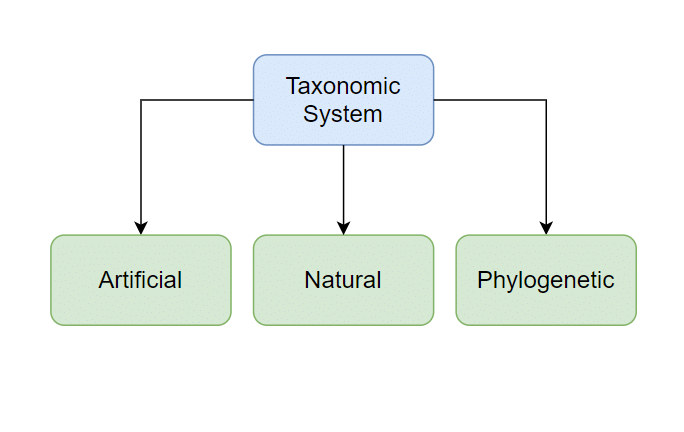 Biological Classification
Biological Classification
Artificial System of Classification
- It is a system of classification which uses one or two morphological characters for the grouping of organisms. Some artificial system has used habit and habitat for this purpose.
- Aristotle (350 BC) divided animals into two categories, Enigma (with red blood) and Anaima (without red blood).
- Aristotle also classified animals on the basis of their habitat- aquatic (e.g, fish, whale), terrestrial (e.g, reptiles, cattle) and aerial (e.g. birds, bat).
- Pliny the Elder (23-79 A.D.) used an artificial system of classification for both plants and animals, dividing them into land, air and water. Pliny distinguished animals into flight and inflight ones. Flight animals included bats, birds and insects.
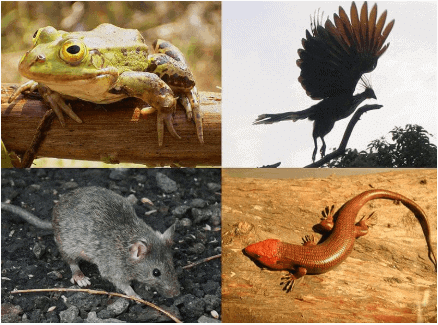 The four classes of extant tetrapods, (clockwise from upper left), Rana(amphibian), Opisthocomus(bird), Eumeces(reptile) and Mus(mammal)
The four classes of extant tetrapods, (clockwise from upper left), Rana(amphibian), Opisthocomus(bird), Eumeces(reptile) and Mus(mammal)
Natural System of Classification
- It is a system of classification that considers a comparable study of a number of characters to bring out the nature of similarities and dissimilarities and, hence, the nature of the relationship among the organisms.
- The system employs those characters which are relatively constant. They include morphological characters, anatomical characters, cytological characters, physiology, ontogeny or development, reproduction, cytochemistry and biochemistry, experimental taxonomy, etc.
- The characteristics are helpful in bringing out a maximum number of similarities in a group and comparable differences with another group of organisms. For example, mammals are characterized by the presence of mammals. Birds possess wings, feathers, pneumatic bones, oviparity, 4- chambered. They are cold-blooded.
Why is the Natural classification system better than the Artificial classification system?
The natural system of classification is certainly better than any artificial system of classification because:
(a) There is stress on the actual study of each and every organism.
(b) There is stress on comparative study.
(c) It brings about affinities on the basis of a number of characters.
(d) It brings out natural relationships amongst organisms.
(e) It places only related organisms in a group.
(f) The system prevents the coming together of unrelated organisms.
(g) The system indicates phylogenetic relationships and the origin of different taxa.
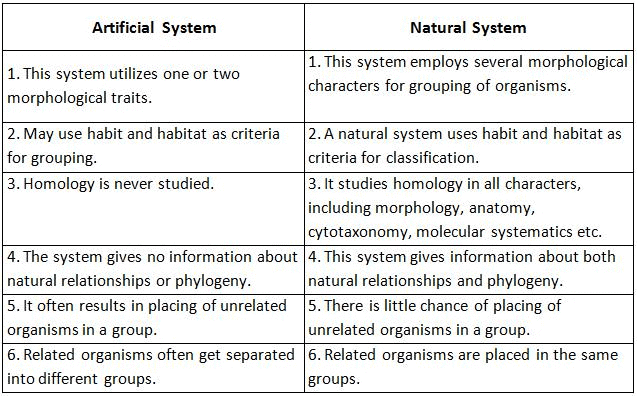
Phylogenetic System of Classification
- Classification based on the evolutionary relationship of organisms is called a phylogenetic system of classification. It is based on Darwin’s book's evolutionary concept- "On the origin of species" by means of natural selection.
- The preservation of favoured races in the struggle for life (1859). It reflects the true relationships among the organisms.
- The first phylogenetic system was proposed by Engler and Prantl (1887-99). Since similarity in structure represents a close evolutionary relationship, geologists believe that their natural classification represents evolutionary and phylogenetic classification.

Phenetic Classification or Taximetrics (Gk. phainein - to appear)
- It is a system of phylogenetic classification which is based on affinities, similarities and dissimilarities of characteristics present in the present-day organisms without searching for the evolution and diversification of these traits in their fossil ancestors.
- The classification obtains supporting evidence from four major branches of taxonomy- cytotaxonomy. chemotaxonomy, numerical taxonomy and cladistic taxonomy.
1. Cytotaxonomy
- It is a classification based on information provided by comparative cytological studies, number of chromosomes, structure and meiotic behaviour of chromosomes.
- It is known that fewer and larger chromosomes have been formed in many cases by the fusion of smaller chromosomes.
- Herbaceous plants have larger chromosomes than woody plants. Naturally, herbaceous plants are more advanced than woody plants.
- In many genera, the same basic chromosome number has been found in different species, e.g. 12 in Solanum species and 9 in Chrysanthemum species.
- Human beings have 46 chromosomes while apes have 48.
- A reduction in the number of chromosomes has been achieved through whole arm translocation between two acrocentric chromosomes.
- Apparently, humans have evolved from ape-like ancestors.
- The pairing of chromosomes during meiosis helps to bring out relationships between
2. Chemotaxonomy (Biochemical Systematics)
- The system of classification is based on characteristics of various chemical constituents of organisms like amino acids proteins, DNA sequences, alkaloids, crystals, betacyanins, etc.
- The chemical constituents of plants are generally specific and stable.
- They do not change easily Ancient medical men based their identification of plants on fragrance, taste and other chemical characteristics.
- Crystals of calcium oxalate like raphides are restricted to 35 families.
- Similarly, certain alkaloids are restricted to a few related families, e.g., benzylisoquinoline alkaloid in Papaveraceae, Berberidaceae and Rammculaceae.

3. Numerical Taxonomy.
- It evaluates resemblances and differences or primitiveness and advancement through statistical methods based on a large number of characters obtained from all disciplines of biology.
- This is followed by assigning them numbers and codes of computer like a plus (+). minus (-), θ (data not I available), followed by computer analysis.
- It establishes the numerical degree of relationship Gong individuals.
- The relationship or affinity values are then used to erect taxonomic Categories.
- However, its effectiveness depends upon the judgement of the biosystematist in selecting characters and current knowledge about them.
4. Cladistic Taxonomy (Clados - sprout).
- It searches for similarity due to common phylogeny or origin from a common ancestor.
- These are two types of characters, ancestral and derived.
- Ancestral characters are traits of basic body design which would be present in an entire group.
- Derived characters are those traits whose structures and functions differ from those of ancestral characters.
- They appear during evolution and cause the formation of new subgroups.
- One or more derived characters would be shared by an entire subgroup.
- In cladistic taxonomy (cladistics) each evolutionary step produces a branching.
- All the members of a branch would possess the derived character.
- It will be absent below the branch point.
- Arranging organisms on the basis of their shared similar or derived characters, that differ from ancestral characters, will produce a phylogenetic tree called a cladogram.
Depending upon the type of system of classification, organisms are classified into two kingdoms or three kingdoms, four kingdoms, five kingdoms and now into six kingdoms.
1. Two Kingdom Classification (Before 1969)
- In the past, all the organisms had been divided into two groups, plants and animals, mainly on the basis of the presence or absence of a cell wall.
- This was also done by Linnaeus (the father of taxonomy).
- He founded two kingdoms- Kingdom Plantae (regnum vegetable) and Kingdom Animalia (regnum animale).
- The members of the kingdom Plantae are plants.
- They are distinguished by
(i) the presence of cell wall,
(ii) occurrence of inorganic crystals in the cells,
(iii) presence of central vacuole in the cell,
(iv) absorption of inorganic nutrients from outside,
(v) well defined growing points with unlimited growth,
(vi) absence of excretory organs, sense organs and nervous system.
(vii) ability to manufacture food due to the presence of chlorophyll-holophytic or autotrophic nutrition,
(viii) reserve food as starch,
(ix) occurrence of branches and less definite shape,
(x) absence of locomotion,
(xi) absence of muscular tissue,
(xii) presence of external organs and
(xiii) slow response to external stimuli. - Members of kingdom Animalia possess the opposite characters as
(i) absence of cell wall,
(ii) inorganic crystals are not present in their cells,
(iii) absence of central vacuole in the cell.
(iv) ingestive (holozoic) type of nutrition,
(v) well-defined growing points absent, growth limited.
(vi) presence of excretory organs, sense organs and nervous system,
(vii) inability to manufacture food due to absence of chlorophyll,
(vii) reserve food as glycogen,
(ix) absence of branches and having definite shape.
(x) presence of locomotion,
(xi) muscular tissue present,
(xii) organs internal and
(xiii) quick response to external stimuli.
Several objections have been raised against this two-kingdom classification. They are:
(i) First formed organisms were neither plants nor animals.
(ii) Fungi differ in the structure, physiology and reproductive details from plants.
(iii) At the lower level of organization, there are several instances where the distinction of plant and animal disappears. For example, Euglena has both holophytic and saprobic nutrition (mixotrophic nutrition). Its relatives have both holophytic and holozoic nutrition. Sponges are branched, fixed and irregular in outline just like plants. Unicellular algae like Chlamydomonas are motile, possess regular shape, definite growth and photosensitive organelles.
(iv) Slime Moulds, a group of fungi, are wall-less in the vegetative phase when nutrition is holozoic. They develop cell walls in the reproductive phase. Slime moulds can neither be placed in fungi, nor plants. This group is popularly called an animal group which is studied by mycologists.
(v) Lichens constitute a peculiar group of dual organisms which are formed by an association between an alga and a fungus. They have no plant character, nor any animal character.
(vi) Viruses have a volume of 106 tot um³., Procaryotes have a volume range of 0.2 to 10 cubic μm³ while the average eukaryotic cell has a volume between 1000-10000 μm³. All of them cannot occur in a single kingdom.
(vii) Prokaryotes have a single compartment or single envelope organization where plasma membrane forms the only covering that encloses the whole cell. Genetic material naked as the organized nucleus is absent. Sexual reproduction, meiosis and spindle apparatus are absent. Viruses have no protoplasm and metabolic machinery of their own. On the other hand, eukaryotes have two envelope or two-compartment organizations. Plasma membrane forms the outer chamber while nuclear envelope creates an inner chamber. Sexual reproduction, meiosis and spindle apparatus are absent. Therefore, the three must be separated from one another.
(viii) Groups of unicellular algae (euglenoids, diatoms and dinoflagellates) and protozoa show a sufficient degree of resemblance.
2. Three Kingdom Classification
- Haeckel (1866) separated unicellular animals, algae and fungi from other organisms on the basis of lack of tissue differentiation.
- The new group was called the kingdom Protista.
- Later on, fungi and multicellular algae were taken out from the group so that kingdom Protista came to have only unicellular organisms divided into three kingdoms-Plantae, Protista and Animalia.
3. Four Kingdom Classification
- With the advent of the electron microscope, it became clear that bacteria and related organisms have a different nuclear structure as compared to others.
- They are prokaryotes in contrast to others which have a true nucleus and are called eucaryotes.
- Copeland (1956) created a separate kingdom of monera (= Mychota) for them.
- This divided the living world into four kingdoms- Monera, Protist, Plantae (Metaphyta) and Animalia (Metazoa).
- In this system, fungi continued to remain with the Plantae.
4. Five Kingdom Classification
Whittaker's five kingdoms are Monera, Protista, Plantae, Fungi and Animalia.
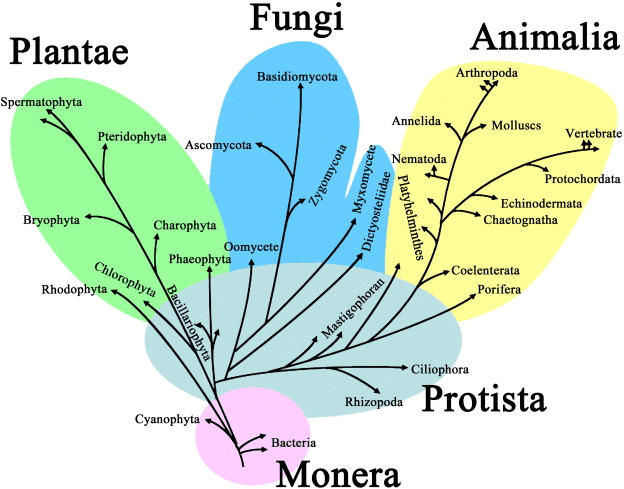
- (From 1969 to 1990) In order to develop phylogenetic classification, R.H. Whittaker (1969), an American taxonomist, divided all the organisms into five kingdoms.
- As the viruses are on the borderline of living and nonliving, they have been left out.
- Whittaker has used five criteria for delimiting the different kingdoms.
(i) Complexity of cell structure, prokaryotic and eucaryotic
(ii) Complexity of body structure or structural organization, unicellular and multicellular.
(iii) Mode of nutrition which is divergent in multicellular kingdoms-photoautotrophy in Plantae, absorptive heterotrophy in fungi and ingestive heterotrophy in Animalia. - Photoautotrophic nutrition is also called holophytic nutrition while ingestive heterotrophy is known as holozoic nutrition.
- Absorptive heterotrophy is saprobiotic (= saprophytic) nutrition.
- The mode of nutrition also determines the ecological lifestyle of producers (Plantae), decomposers (fungi) and consumers (Animalia).
(iv) Presence or absence of sexual reproduction, mode of sexual reproduction.
(v) Phylogenetic relationships.
Monera- Kingdom of Prokaryotes
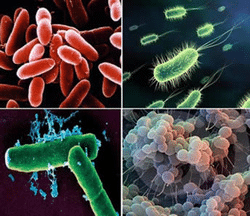 Kingdom Monera
Kingdom Monera
- The kingdom includes all procaryotes- mycoplasma, bacteria, actinomycetes and cyanobacteria or blue-green algae.
- Along with fungi, they are decomposers and mineralizers of the biosphere.
(i) Monerans are basically unicellular (monos-single) procaryotes and contain the most primitive of living forms.
(ii) They are varied in their nutrition-saprobic, parasitic, chemoautotrophic, photoautotrophic and symbiotic. The photoautotrophs include both aerobes and anaerobes.
(iii) The cells are microscopic (0.1 to a few microns in length).
(iv) Cell wall is generally present. It contains peptidoglycan and polysaccharides other than cellulose.
(v) Cells have one envelope type of organization, i.e., the whole protoplast is covered by plasma membrane but internal compartmentalization is absent.
(vi) Genetic material is not organized into a nucleus.
(vii) DNA is naked, i.e. it is not associated with histone proteins. DNA lies coiled inside the cytoplasm. The coiled mass is known as the nucleoid. It is equivalent to a single chromosome.
(viii) All membrane-bound cell organelles are absent, e.g., mitochondria, lysosomes, spherosomes, Golgi bodies, plastids, etc.
(ix) The flagella, if present, are single-stranded instead of being 11 stranded in eucaryotes. They are formed of a protein called flagellin.
(x) Mitotic spindle is absent.
(xi) Gametes are absent. Gene recombination has been discovered in certain cases. Otherwise, reproduction is by asexual methods.
(xii) Some of the monerans have the ability to convert dinitrogen into an ammonia state.
Protista - Unicellular Eukaryotic Organisms
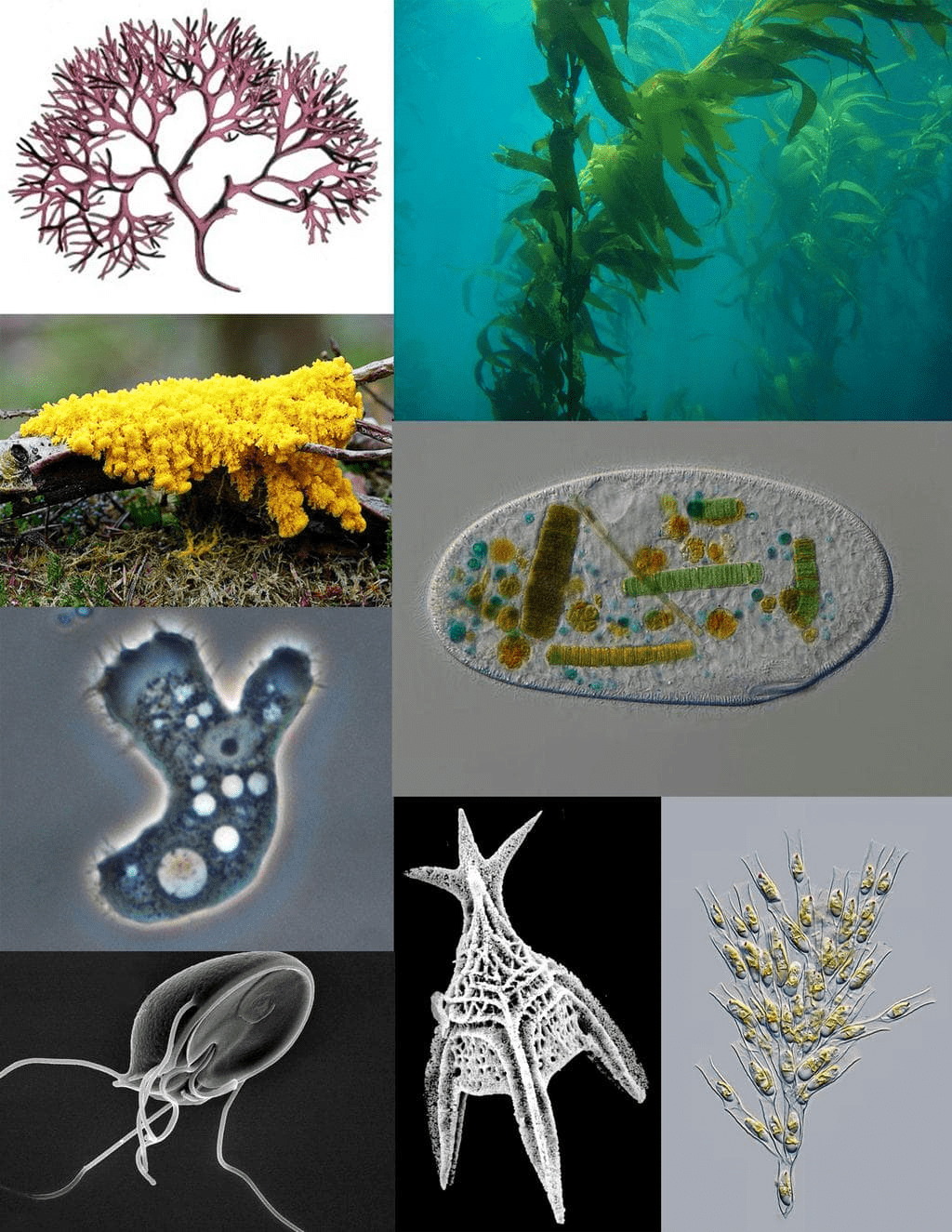 Kingdom Protista
Kingdom Protista
- It is the kingdom of unicellular eukaryotic organisms.
- Kingdom Protista has brought together Chlamydomonas, Chlorella (earlier placed in Algae within Plants and both having cell walls) with Paramoecium and Amoeba (which were earlier placed in the animal the kingdom which lacks a cell wall.
- Kingdom Protista includes flagellates (euglenophyceae), diatoms, dinoflagellates, slime moulds, sarcodines, ciliates, sporozoans.
- The important characteristics are:
(i) It includes all unicellular and colonial eucaryotes.
(ii) Mostly they are aquatic organisms forming plankton.
(iii) They have diverse modes of nutrition- photosynthetic, saprobic, parasitic, ingestive, or Holozoic etc.
(iv) The photosynthetic plankton are called phytoplankton. They usually p possess cell walls and constitute an important group of producers. The non-photosynthetic, wall-less and holozoic plankton are called zooplankton. Holozoic nutrition involves the ingestion of particulate food. The protistans having holozoic nutrition are collectively called protozoa, though they have been excluded from kingdom Animalia.
(v) There is a group of Euglena-like organisms which have a dual mode of nutrition, holophytic or photosynthetic in light and holozoic in absence of light or the presence of abundant organic matter. Slime moulds are a group of Protista that are intermediate between wall-less and walled organisms. They are devoid of a wall in the vegetative phase. In the vegetative phase, the nutrition is of ingestive type. In the reproductive phase, the slime moulds come to have cell walls.
(vi) The cellular organization is of two envelope types. i.e., besides plasma membrane, internal membranes occur around certain organelles.
(vii) Genetic material is organized in the form of a nucleus. DNA is associated with histone proteins.
(viii) The aerobic forms possess mitochondria. The endoplasmic reticulum, Golgi bodies, lysosomes and. centrioles occur.
(ix) Flagella, if present, are 11 stranded with 9 + 2 organization of microtubules that are composed of a protein named tubulin.
(x) Both sexual and asexual modes of reproduction are present. However, an embryo stage is absent.
(xi) Tissue system is absent.
Kingdom Protista does not seem to be a natural group due to
(i) Dinoflagellates are mesokaryotic and not eukaryotic.
(ii) A distinction between unicellular protistan algae and green algae included in Volvocales is not valid.
(iii) Slime moulds are quite distinct from the rest of the protists
(iv) There are several evolutionary lines in Protista.
(v) Protists of this kingdom have diverse modes of form, structure and life.
Fungi- Kingdom of Multicellular Decomposers
The kingdom includes moulds, mildews, yeasts, rust-causing fungi, Penicillium, morels. mushrooms, puffballs, bracket fungi, etc. ie. all the fungi of the two kingdom classification except slime moulds.
(i) It contains achlorophyllous, spore-producing, multicellular or multinucleate eukaryotic organisms. Basically unicellular yeasts are also included amongst fungi because their sexual reproduction is similar to that of some fungi.
(ii) The organisms are heterotrophic with an absorptive type of nutrition. It is either saprobic or parasitic. Symbiotic association occurs with some algae and higher plants, e.g., lichens, mycorrhiza. The saprobic fungi excrete hydrolytic or digestive enzymes in the external medium for digesting complex organic compounds. The parasitic fungi absorb nourishment directly from another living organism called the host.
(iii) The body of the fungus is filamentous and is called mycelium. The filaments are known as hyphae.
(iv) Hyphae are either multicellular or multinucleate Nuclei are very small and show intranuclear spindle.
(v) The wall contains chitin and noncellulosic polysaccharides. Cellulose also occurs in a few cases
(vi) The cellular organization is two envelope types.
(vii) In most cases, Golgi bodies are unicisternal.
(viii) Reproduction is both asexual and sexual.
(ix) Vegetative body or mycelium is not clear externally in most cases due to its subterranean nature. Reproductive bodies are, however, apparent as in mushrooms, toadstools, puffballs, bracket fungi.
(x) Tissue differentiation is absent.
(xi) Food reserve is glycogen and fat.
The kingdom is important in nutrient cycling because along with some protistans and monerans, fungi are decomposers and mineralizers of the biosphere.
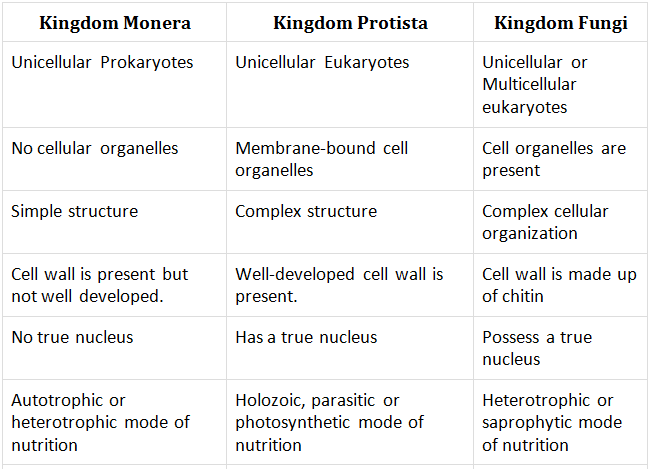
Plantae-Kingdom of Multicellular Producers or Metaphyta
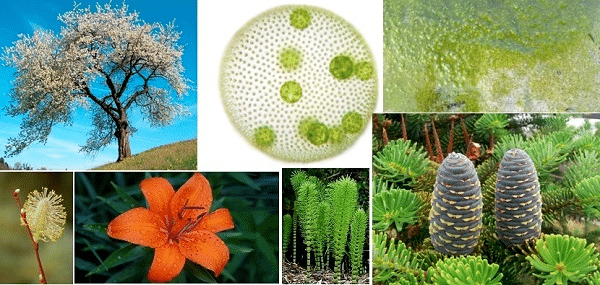 Kingdom Plantae
Kingdom Plantae
- The kingdom contains all photosynthetic eukaryotic multicellular plants and their non-photosynthetic relatives.
- The lower level contains multicellular algae- green, brown and red algae.
- Other groups included in the kingdom Plantae are bryophytes, pteridophytes and spermatophytes.
- Important characters of this kingdom are as follows:
(i) Organisms are multicellular.
(ii) They are eucaryotic.
(iii) Body form is less regular.
(iv) Growth is usually indefinite.
(vi) Organs are commonly external.
(vii) Irritability is poor.
(viii) Mode of nutrition is autotrophic.
(ix) The photosynthetic regions contain plastids in their cells. Due to photosynthetic activity, plants are called producers.
(x) Most of the plants are restricted to land, seashores and freshwater reservoirs.
(xi) The plants are usually fixed or free-floating. Active locomotion is generally absent. (xii) Structural differentiation into tissues is found except for certain algae.
(xiii) Food reserve is usually starch and fat.
(xiv) Some of the plants are heterotrophic. They are mostly parasitic. A few are saprobes. A small group of autotrophic plants catch small animals and insects for obtaining extra nitrogen. They are called carnivorous or insectivorous plants.
(xv) Reproduction is both asexual and sexual. Accessory spores are present in lower plants. An embryo stage is absent in the algal group but is present in others.
Animalia - Kingdom of Multicellular Consumers or Metazoa
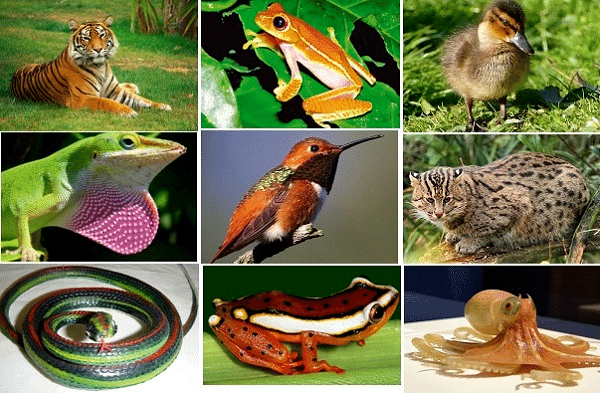 Kingdom Animilia
Kingdom Animilia
- Members of this kingdom are also known as metazoa or multicellular animals.
- The kingdom has a maximum number and the most diverse types of organisms.
- It includes all the animals of the two kingdom classifications except Protozoa.
- Groups included are sponges, coelenterates, worms, molluscs, arthropods Starfishes and vertebrates like fishes, amphibians, reptiles, birds and mammals.
- Insects, a group of arthropods, outnumber all other organisms in variety and number.
- The important characteristics of Animalia are:
(i) Organisms are multicellular eukaryotes.
(ii) Body form is regular.
(iii) Organs are internal.
(iv) Growth is definite, Well-defined growing points are absent.
(v) Cellular, tissue and organ system levels of organization occur in different groups. (vi) Response to stimuli is quick.
(vii) A cell does not possess a central vacuole. Instead, small vacuoles may occur. (viii) Centrioles occur in the cells.
(ix) A cell wall is absent.
(x) Plastids and photosynthetic pigments are absent.
(xi) The organisms have the holozoic or ingestive types of nutrition. A few animals are, however, parasitic. They live on or inside the bodies of other eucaryotes.
(xii) Animals are motile or mobile they have to search for their food. Sponges and corals are an exception.
(xiii) The organisms possess muscle cells for their mobility and nerve cells for conduction of impulses. They are, however, absent in sponges.
(xiv) Reproduction is mostly sexual. Regeneration of whole organisms and formation of spores are found in lower animals.
(xv) Embryo stage is present.
(xvi) Ecologically animals are consumers. These consumers. constitute links in the food chains and food webs.
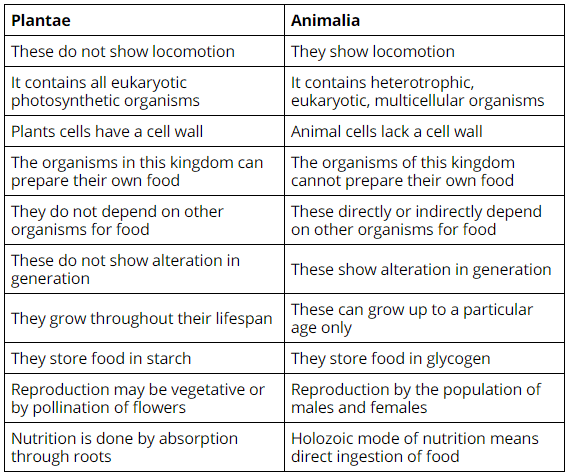
Advantages of Five Kingdom Classification
1. Separation of prokaryotes in a separate kingdom of Monera is a wise step because procaryotes differ from all other organisms in their genetic, cellular, reproductive and physiological organization.
2. Many transitional or intermediate forms are present in the unicellular eucaryotes which had been included both amongst plants and animals. The separation of unicellular eukaryotes into kingdom Protista has removed this anomaly.
3. Fungi have never been related to plants. They have their own biochemical, physiological and structural organization. The separation of fungi into a separate kingdom was long overdue.
4. The five-kingdom classification is based on levels of organization and nutrition which overdue evolved very early and became established in later groups that are existing today. 5. In this classification, animal and plant kingdoms are more homogeneous than they are in the two-kingdom classification.
6. It has tried to bring out phylogenetic relationships even amongst the primitive forms.
Characteristics of Five Kingdom Classification

Drawbacks of Five Kingdom Classification
1. In real terms the phylogenetic system cannot be established till all the distinct evolutionary tendencies are separated. This is not possible at the lower level. For example, certain green algae are known to obtain hydrogen from sources other than water like photosynthetic bacteria. Similarly, Euglena can be photosynthetic as well as saprotrophic. Its relatives can have absorptive as well as ingestive types of heterotrophic nutrition.
2. A distinction between unicellular and multicellular organisms is not possible in the case of algae. It is because of this that unicellular green algae have not been included in the kingdom Protista by Whittaker.
3. Each group has so many diversities that it is difficult to keep them together. For example, monera and Protista contain both walled and wall-less organisms, photosynthetic and nonphotosynthetic organisms, unicellular and filamentous or mycelial organisms.
4. Viruses have not been included in this system of classification.
5. Archaebacteria differ from other bacteria in structure, composition and physiology.
6. Mycoplasmas are quite different from bacteria where they have been placed along with
prokaryotes.
Three Domains of Life (Six Kingdom Classification) - 1990
- The three-domain system is a biological classification that was introduced by Carl Woese, a professor in the Department of Microbiology, y. The University of Illinois, Urbana Champaign in 1990 that divides cellular life forms into archaea, bacteria and eukarya domains.
- It emphasizes the separation of prokaryotes into two groups, called Archaea and Bacteria because of their fundamental differences.
- Woese argued that each of the two arose separately from an ancestor with poorly developed genetic machinery, often called a progenote.
In fact, the three-domain system is loosely based on the traditional five-kingdom system but divides the Monera into two "domains" leaving the remaining eukaryotic kingdoms in the third domain.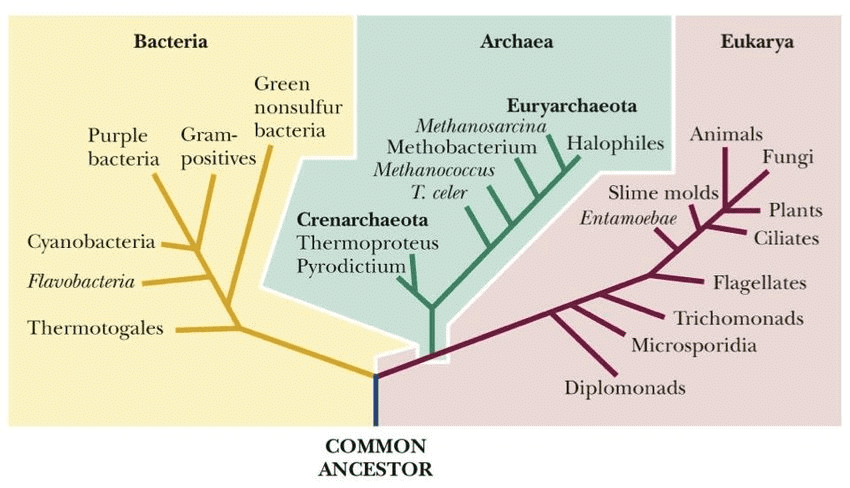
Archaea Domain
The domain contains prokaryotic organisms which have a monolayer core of lipids in the cell membrane and distinct nucleotides in their 16S rRNA. It contains a single kingdom.
Kingdom Archaebacteria: The kingdom contains early prokaryotes which live in extreme environments.
Example:
- Methanogens- metabolize hydrogen and carbon dioxide into methane.
- Halophiles- Live in salt.
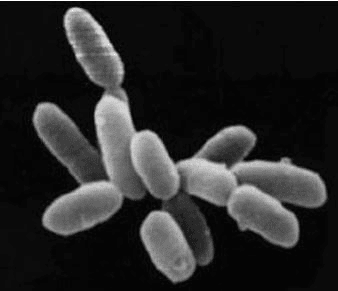 Halophiles
Halophiles
- Thermoacidophiles- live in acid-high temperatures (up to 110 degrees Celsius).
Bacteria Domain
- The domain contains prokaryotes that lack membrane-covered cell organelles but do have microchambers for separating various activities. There is a single kingdom.
- Kingdom eubacteria: The domain contains a diverse type of bacteria having a peptidoglycan cell wall, glycogen as a food reserve, naked DNA coiled to form nucleoid, the absence of sap vacuoles and the presence of 70S ribosomes. Some common groups are bacteria, mycoplasma, actinomycetes, rickettsiae, spirochaetes, firmicutes, cyanobacteria.
Eukarya Domain
The domain contains eukaryotic organisms which originated by the endosymbiotic association between some archaebacteria and eubacteria.
It has four kingdoms- Protista, Fungi, Plantae and Animalia.
|
219 videos|306 docs|270 tests
|
FAQs on Introduction to Biological Classification - Biology for Grade 11
| 1. What is biological classification? |  |
| 2. Why is classification important in biology? |  |
| 3. What are the objectives of classification in biology? |  |
| 4. What are the types of biological classification? |  |
| 5. What are the advantages of the five kingdom classification system? |  |





















